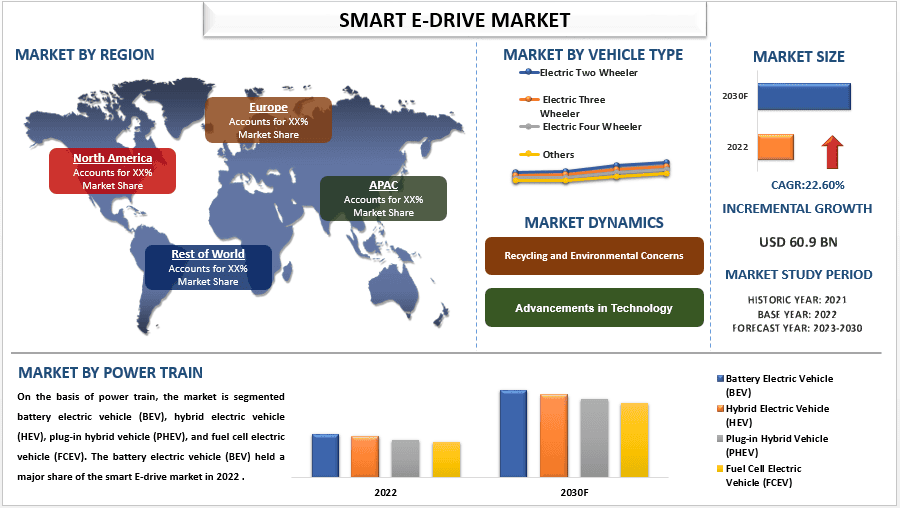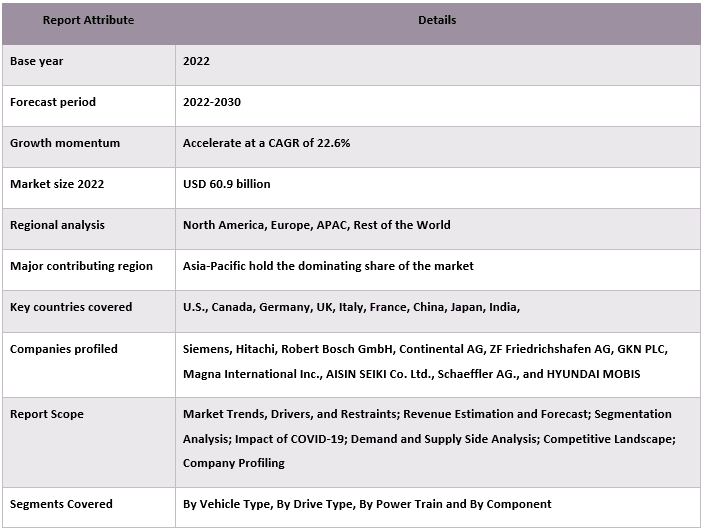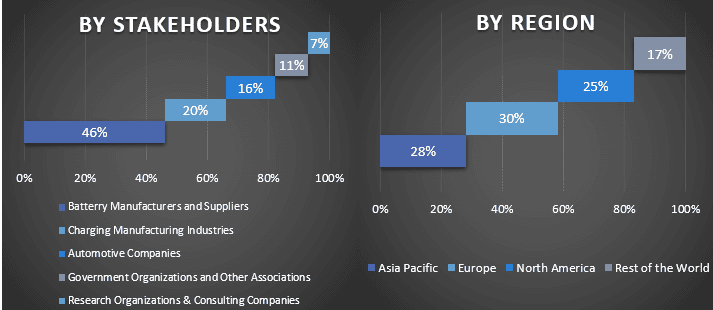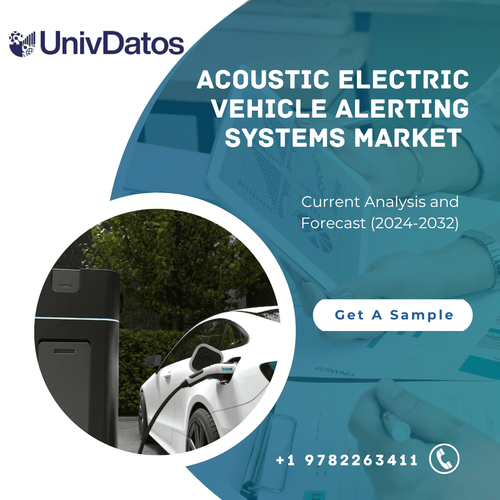Smart E-Drive Market: Current Analysis and Forecast (2023-2030)
Emphasis on Vehicle Type (Electric Two-Wheeler, Electric Three-Wheeler, Electric Four-Wheeler and Others); and Component (Electric Motor, Inverter System, E-Brake Boosters, and Power Electronics); Power Train (Battery Electric Vehicle (BEV), Hybrid Electric Vehicle (HEV), Plug-In Hybrid Vehicle (PHEV), And Fuel Cell Electric Vehicle (FCEV) and Drive Type (Front Wheel Drive, Rear Wheel Drive, and All-Wheel Drive)); and Region/Country

The Smart E-Drive Market was valued at USD 60.9 billion in 2022 & is expected to grow at a CAGR of 22.6.0% from 2022-2030. The global scenario for smart e-drive is rapidly evolving, driven by a range of factors such as environmental concerns, energy security, and technological advancements. One of the key drivers is advancement in electric motors, power electronics, and charging infrastructure are also improving the efficiency and convenience of EVs. This has made them more attractive to consumers and has led to an increase in investment and policies in support of smart e-drive. Investment in EV manufacturing and charging infrastructure is a key driver of the growth of electric mobility. Companies such as Tesla, Volkswagen, and Nissan have announced billion-dollar investments in EV manufacturing and charging infrastructure. Governments around the world are also investing in EV infrastructure, with initiatives such as the European Union’s Alternative Fuels Infrastructure Regulation and the US Department of Energy’s Vehicle Technologies Office. For example, the European Union has set a target of achieving 30% of new car sales to be electric by 2030, and China has announced plans to phase out internal combustion engine vehicles by 2035. These policies are designed to increase the adoption of electric vehicles and to support the growth of the smart e-drive industry.
Some of the major players operating in the market include Honda, Hyundai, Volvo, Toyota, Nissan Moto, Tesla Motors, BYD, Volkswagen, Ford, and Daimler. Several M&As along with partnerships have been undertaken by these players to facilitate customers with hi-tech and innovative products/technologies.
Insights Presented in the Report
“Amongst power train, the plug-in hybrid vehicle (PHEV) segment held significant growth in the market in 2021.”
On the basis of power train, the market is segmented battery electric vehicle (BEV), hybrid electric vehicle (HEV), plug-in hybrid vehicle (PHEV), and fuel cell electric vehicle (FCEV). Amongst these, the plug-in hybrid vehicle (PHEV) segment held significant growth because PHEV offers the benefits of both electric and internal combustion engines. Additionally, PHEVs offer flexibility which addresses the range limitation of electric vehicles and provide an extra range with an ICE engine powertrain. Moreover, advancements in battery technology have evolved making them offer more range as compared to electric vehicles, which may them an attractive option to consumers.
“Amongst vehicle type, the three-wheeler segment held the significant growth of the market in 2021.”
Based on vehicle type, the market is segmented into electric two-wheeler, electric three-wheeler, electric four-wheelers and others. Among these, three-wheeler held significant growth in the smart e-drive market in 2021. The significant growth of three-wheelers can be attributed to three-wheelers are typically more affordable than four-wheel vehicles, both in terms of purchase price and operating costs. This affordability makes them an attractive option for a wide range of consumers, especially in emerging markets where cost-consciousness is a key factor. As more Advances in battery technology and electric drivetrain systems have improved the performance and range of electric three-wheelers. This has alleviated some of the earlier limitations associated with electric vehicles, making them more attractive to consumers.
“Europe is experiencing significant growth in the smart e-drive market in 2021.”
Europe’s smart e-drive market is growing at a high rate, driven by concerns about the environment, fuel costs, and the desire for more innovative and sustainable transportation options. Europe has some of the strictest environmental regulations and emissions standards in the world. This has pushed the automotive industry towards electrification and the adoption of smart e-drive technologies to reduce emissions and meet regulatory requirements. Moreover, many European governments offer generous incentives and subsidies to encourage the adoption of electric vehicles (EVs), including tax incentives, rebates, and reduced registration fees. These incentives make EVs more affordable for consumers and incentivize manufacturers to produce smart e-drive vehicles. For instance, in 2021, BMW announced plans to invest $10.6 billion in the development of electric and autonomous vehicles over the next five years. The company also announced that it will launch 25 new electric models by 2025, with the aim of producing only electric vehicles by 2030. Several countries in Europe introduced new incentives to encourage the adoption of electric vehicles, including tax breaks and subsidies.
Smart E-Drive Market Report Coverage

Reasons to buy this report:
- The study includes market sizing and forecasting analysis validated by authenticated key industry experts.
- The report presents a quick review of overall industry performance at one glance.
- The report covers an in-depth analysis of prominent industry peers with a primary focus on key business financials, product portfolios, expansion strategies, and recent developments.
- Detailed examination of drivers, restraints, key trends, and opportunities prevailing in the industry.
- The study comprehensively covers the market across different segments.
- Deep dive regional level analysis of the industry.
Customization Options:
The global smart e-drive market can further be customized as per the requirement or any other market segment. Besides this, UMI understands that you may have your own business needs, hence feel free to connect with us to get a report that completely suits your requirements.
Table of Contents
Research Methodology for the Smart E-Drive Market Analysis (2023-2030)
Analyzing the historical market, estimating the current market, and forecasting the future market of the global smart e-drive market were the three major steps undertaken to create and analyze the adoption of smart e-drive in major regions globally. Exhaustive secondary research was conducted to collect the historical market numbers and estimate the current market size. Secondly, to validate these insights, numerous findings and assumptions were taken into consideration. Moreover, exhaustive primary interviews were also conducted, with industry experts across the value chain of the global smart e-drive market. Post assumption and validation of market numbers through primary interviews, we employed a top-down/bottom-up approach to forecasting the complete market size. Thereafter, market breakdown and data triangulation methods were adopted to estimate and analyze the market size of segments and sub-segments of the industry pertains to. Detailed methodology is explained below:
Analysis of Historical Market Size
Step 1: In-Depth Study of Secondary Sources:
Detail secondary study was conducted to obtain the historical market size of the smart e-drive market through company internal sources such as annual reports & financial statements, performance presentations, press releases, etc., and external sources including journals, news & articles, government publications, competitor publications, sector reports, third-party database, and other credible publications.
Step 2: Market Segmentation:
After obtaining the historical market size of the smart e-drive market, we conducted a detailed secondary analysis to gather historical market insights and share for different segments & sub-segments for major regions. Major segments are included in the report as vehicle type, drive type, power train and component. Further country-level analyses were conducted to evaluate the overall adoption of testing models in that region.
Step 3: Factor Analysis:
After acquiring the historical market size of different segments and sub-segments, we conducted a detailed factor analysis to estimate the current market size of the smart e-drive market. Further, we conducted factor analysis using dependent and independent variables such as vehicle type, drive type, power train and component of the smart e-drive market. A thorough analysis was conducted for demand and supply-side scenarios considering top partnerships, mergers and acquisitions, business expansion, and product launches in the smart e-drive market sector across the globe.
Current Market Size Estimate & Forecast
Current Market Sizing: Based on actionable insights from the above 3 steps, we arrived at the current market size, key players in the global smart e-drive market, and market shares of the segments. All the required percentage shares split, and market breakdowns were determined using the above-mentioned secondary approach and were verified through primary interviews.
Estimation & Forecasting: For market estimation and forecast, weights were assigned to different factors including drivers & trends, restraints, and opportunities available for the stakeholders. After analyzing these factors, relevant forecasting techniques i.e., the top-down/bottom-up approach were applied to arrive at the market forecast for 2028 for different segments and sub-segments across the major markets globally. The research methodology adopted to estimate the market size encompasses:
- The industry’s market size, in terms of revenue (USD) and the adoption rate of the smart e-drive market across the major markets domestically
- All percentage shares, splits, and breakdowns of market segments and sub-segments
- Key players in the global smart e-drive market in terms of products offered. Also, the growth strategies adopted by these players to compete in the fast-growing market
Market Size and Share Validation
Primary Research: In-depth interviews were conducted with the Key Opinion Leaders (KOLs) including Top Level Executives (CXO/VPs, Sales Head, Marketing Head, Operational Head, Regional Head, Country Head, etc.) across major regions. Primary research findings were then summarized, and statistical analysis was performed to prove the stated hypothesis. Inputs from primary research were consolidated with secondary findings, hence turning information into actionable insights.
Split of Primary Participants in Different Regions

Market Engineering
The data triangulation technique was employed to complete the overall market estimation and to arrive at precise statistical numbers for each segment and sub-segment of the global smart e-drive market. data was split into several segments & sub-segments post studying various parameters and trends in the areas of the vehicle type, drive type, power train and component in the global smart e-drive market.
The main Objective of the Global Smart E-Drive Market Study
The current & future market trends of the global smart e-drive market were pinpointed in the study. Investors can gain strategic insights to base their discretion for investments on the qualitative and quantitative analysis performed in the study. Current and future market trends determined the overall attractiveness of the market at a regional level, providing a platform for the industrial participant to exploit the untapped market to benefit from a first-mover advantage. Other quantitative goals of the studies include:
- Analyze the current and forecast market size of the smart e-drive market in terms of value (USD). Also, analyze the current and forecast market size of different segments and sub-segments.
- Segments in the study include areas of the vehicle type, drive type, power train and component.
- Define and analysis of the regulatory framework for the smart e-drive
- Analyze the value chain involved with the presence of various intermediaries, along with analyzing customer and competitor behaviors of the industry.
- Analyze the current and forecast market size of the smart e-drive market for the major region.
- Major countries of regions studied in the report include Asia Pacific, Europe, North America, and the Rest of the World
- Company profiles of the smart e-drive market and the growth strategies adopted by the market players to sustain in the fast-growing market.
- Deep dive regional level analysis of the industry
Related Reports
Customers who bought this item also bought










